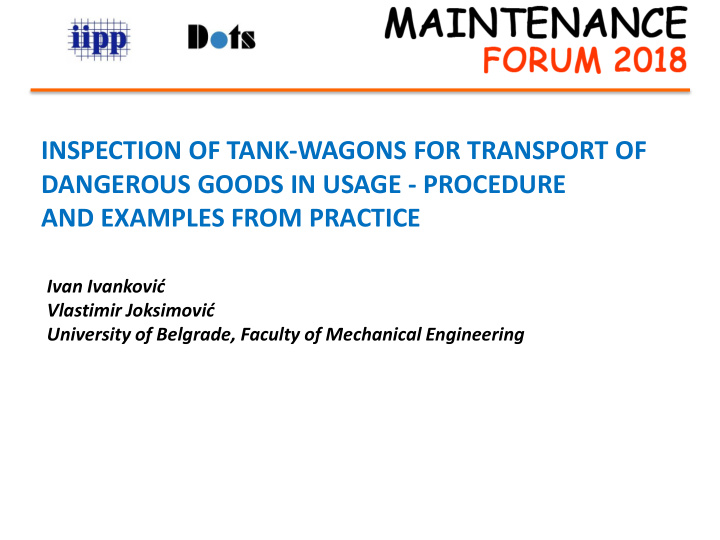



INSPECTION OF TANK-WAGONS FOR TRANSPORT OF DANGEROUS GOODS IN USAGE - PROCEDURE AND EXAMPLES FROM PRACTICE Iva� Iva�ković Vlasti�ir Joksi�ović University of Belgrade, Faculty of Mechanical Engineering
INTRODUCTION Characteristics of the substance that is transported in the tank determine: -material, -geometric characteristics, -production process, -tank equipment, -as well as special requirements related to the protection and insulation of the interior or exterior of the tank or the heating of the substance during transport.
PERIODIC INSPECTION OF TANKS The norm applicable to inspection of a tank-wagons for transport of dangerous goods in accordance with the Regulations concerning the International Carriage of Dangerous goods by Rail (RID) is EN 12972 (Tanks for transport of dangerous goods - testing, inspection and marking of metallic tanks). Norm EN 12972 includes: • type approval, • initial inspection, • periodic inspection, • intermediate inspection, • and exceptional checks. The essence of inspection is to determine: • whether the integrity of the body of the tank has been violated (cracks, deformation, reduced wall thickness, damage of the protective lining or coating); • the functionality of its service equipment, and whether it is in accordance with the approved type, or requirements of the applicable regulations; • is the necessary leakproofness of the closures, covers and other elements of the equipment provided.
EXAMPLE 1 - tank-wagon for the transport of phosphoric acid
EXAMPLE 2 - tank-wagons for the transport of acetic acid
EXAMPLE 3 - tank-wagon for the transportation of oil derivatives
EXAMPLE 4 - tank-wagon for the transportation of oil derivatives
EXAMPLE 5 - tank-wagon for the transportation of oil derivatives
EXAMPLE 6 - tank-wagon for the transport of concentrated sulfuric acid
CONCLUSION Considering the characteristics of dangerous goods carried in tank-wagons and environmental hazards in the event of leakage or spillage in case of tank or equipment failure, as well as the need for the tank to function properly in its design life, it is necessary to strictly observe the prescribed usage procedure, provide adequate maintenance of the tank and its equipment, as well as periodic inspections prescribed by RID, which must be carried out in accordance with the applicable norm (EN 12972). In this way, in addition to reducing the immobilization (which lead to a greater utilization of the tank in its design life), the safety of the transport of dangerous goods in tank-wagons is significantly increased.
Thank You for Your attention!
Recommend
More recommend